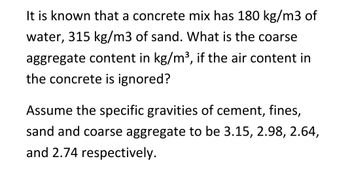
Structural Analysis
6th Edition
ISBN: 9781337630931
Author: KASSIMALI, Aslam.
Publisher: Cengage,
expand_more
expand_more
format_list_bulleted
Question

Transcribed Image Text:It is known that a concrete mix has 180 kg/m3 of
water, 315 kg/m3 of sand. What is the coarse
aggregate content in kg/m³, if the air content in
the concrete is ignored?
Assume the specific gravities of cement, fines,
sand and coarse aggregate to be 3.15, 2.98, 2.64,
and 2.74 respectively.
Expert Solution
This question has been solved!
Explore an expertly crafted, step-by-step solution for a thorough understanding of key concepts.
Step by stepSolved in 3 steps

Knowledge Booster
Learn more about
Need a deep-dive on the concept behind this application? Look no further. Learn more about this topic, civil-engineering and related others by exploring similar questions and additional content below.Similar questions
- The relative amounts of the four chemicals in the final cement depends on the desired properties of the cement concrete. The table below gives the typical compound composition of different types of Portland cements Compound Composition No. C3S C,S C3A C4AF 1 60 13 9. 8 40 40 4 3 26 50 5 12 4 50 24 11 5 42 33 5 13 Depending on the properties of the different chemicals and their relative composition, identify the high early strength (HE) and low-heat (LH) cements from the table. Give detail explanation for your answerarrow_forwardplease quickly thanks !arrow_forward10. A sample of coarse aggregate weighs 1072 g when oven- dried, 1091 g when saturated surface-dried, and 667.6 g when submerged. Calculate the bulk specific gravity, apparent specific gravity, and absorption.arrow_forward
- (c) Table 1 shows the mass of fine aggregates used to conduct a specific gravity test. Calculate the; i) Dry bulk specific gravity ii) SSD bulk specific gravity i) Apparent specific gravity iv) Aggregate absorption. Table 1 Mass of Aggregate 600 g SSD Mass of Aggregate 589 g Mass of pycnometer with water 710 g Mass of pycnometer with water and aggregate 1090 g Mass of aggregate at cool temperature 498 garrow_forwardIs it correct to say that the fineness modulus of aggregate B is 0.44 asumming aggregate B is a fine aggregate and also that the percent passing the 1.18mm, No. 16 sieve is 56%?arrow_forwardA concrete mix has the following ratio, excluding water, of cement:sand:gravel (3:6:7). How much gravel would be needed in 860 cubic meters of the dry mix? Round your answer to the nearest whole number.arrow_forward
arrow_back_ios
arrow_forward_ios
Recommended textbooks for you

 Structural Analysis (10th Edition)Civil EngineeringISBN:9780134610672Author:Russell C. HibbelerPublisher:PEARSON
Structural Analysis (10th Edition)Civil EngineeringISBN:9780134610672Author:Russell C. HibbelerPublisher:PEARSON Principles of Foundation Engineering (MindTap Cou...Civil EngineeringISBN:9781337705028Author:Braja M. Das, Nagaratnam SivakuganPublisher:Cengage Learning
Principles of Foundation Engineering (MindTap Cou...Civil EngineeringISBN:9781337705028Author:Braja M. Das, Nagaratnam SivakuganPublisher:Cengage Learning Fundamentals of Structural AnalysisCivil EngineeringISBN:9780073398006Author:Kenneth M. Leet Emeritus, Chia-Ming Uang, Joel LanningPublisher:McGraw-Hill Education
Fundamentals of Structural AnalysisCivil EngineeringISBN:9780073398006Author:Kenneth M. Leet Emeritus, Chia-Ming Uang, Joel LanningPublisher:McGraw-Hill Education
 Traffic and Highway EngineeringCivil EngineeringISBN:9781305156241Author:Garber, Nicholas J.Publisher:Cengage Learning
Traffic and Highway EngineeringCivil EngineeringISBN:9781305156241Author:Garber, Nicholas J.Publisher:Cengage Learning


Structural Analysis (10th Edition)
Civil Engineering
ISBN:9780134610672
Author:Russell C. Hibbeler
Publisher:PEARSON

Principles of Foundation Engineering (MindTap Cou...
Civil Engineering
ISBN:9781337705028
Author:Braja M. Das, Nagaratnam Sivakugan
Publisher:Cengage Learning

Fundamentals of Structural Analysis
Civil Engineering
ISBN:9780073398006
Author:Kenneth M. Leet Emeritus, Chia-Ming Uang, Joel Lanning
Publisher:McGraw-Hill Education


Traffic and Highway Engineering
Civil Engineering
ISBN:9781305156241
Author:Garber, Nicholas J.
Publisher:Cengage Learning